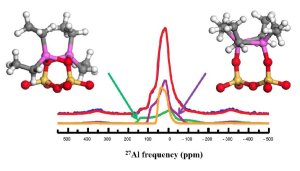Ask for a reprint
email :
* Give your email
2012
ACL
|
R.N.Kerber, A.Kermagoret, E.Callens, P.Florian, D.Massiot, A.Lesage, C.Copéret, F.Delbecq, X Rozanska, P.Sautet, 'Nature and structure of aluminum surface sites grafted on silica from a combination of high field aluminum-27 solidstate NMR spectroscopy and first principle calculations', J. Am. Chem. Soc. 134 6767–6775 (2012) doi:10.1021/ja3008566
The determination of the nature and structure of surface sites after chemical modification of large surface area oxides such as silica is a key point for many applications and challenging from a spectroscopic point of view. This has been for instance a long-standing problem for silica reacted with alkyl aluminum compounds, a system typically studied as a model for supported methylaluminoxane and aluminum co-catalyst. While 27Al solid state NMR spectroscopy would be a method of choice, it has been difficult to apply this technique because of large quadrupolar broadenings. Here from a combined use of the highest stable field NMR instruments (17.6, 20.0 and 23.5 T) and ultra-fast magic angle spinning (>60 kHz), high quality spectra were obtained, allowing isotropic chemical shifts, quadrupolar couplings and asymmetric parameters to be extracted. Combined with first principle calculations, these NMR signatures were then assigned to actual structures of surface aluminum sites. For silica (here SBA-15) reacted with triethylaluminum, the surface sites are in fact mainly dinuclear Al species, grafted on the silica surface via either two terminal or two bridging siloxy ligands. Tetrahedral sites, resulting from the incorporation of Al inside the silica matrix, are also seen as minor species. No evidence for putative tri-coordinated Al atoms has been found.
|

|